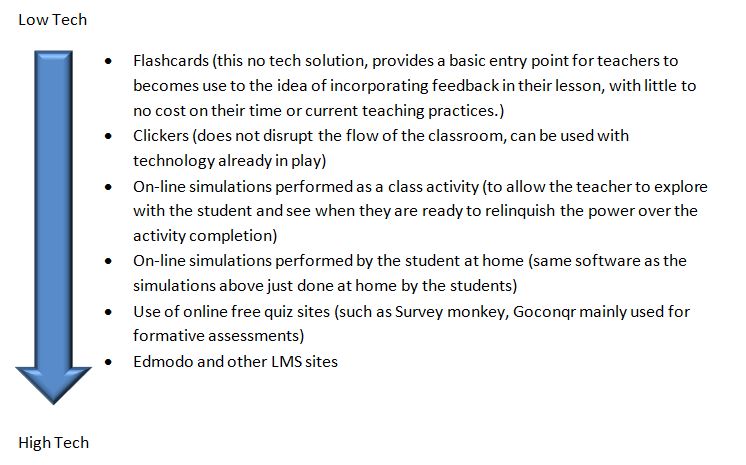Due to the looming final ministerial exit exam, the manner in which our department assessed its students changed. Teachers, pressed for time, hurried through the concepts that might be covered on the final. Amidst the chaos generated by the genuine desire for our students to succeed on this exam, we omitted formative assessment, as well as, opportunities to provide detailed and relevant feedback; we provided grades. Quite honestly we have lost most if not all of the conditions set out by Gibbs, Simpson, Gravestock, and Hills (2005) for effective assessment. It seems counter-intuitive, yet when faced with growing fears of failure we wanted to drill the knowledge into the students. Good intentions, poor results.
This rush not only pushed aside formative assessment but also modified the format of summative assessments. In order to best mimic the final exam, projects, case studies, portfolios and to a certain extent complex labs were replaced by paper quizzes and tests. In some terms, this form of summative evaluation accounts for 90% of the student’s grade. In such a context, you must understand that technology, even the use of science simulations, is a very rare practice.
On the positive side I must say that the opportunities of using technology in this context are endless as one is faced with a blank canvas. Technology could be used to provide feedback, formative assessments; we do not have to deal with technology being misused and revising existing behavior, technology simply is just not being used at all. However, as we are not using technology, even though it is at our disposal, we must contend with two enormous challenges; tradition and fear.
Interestingly enough, I see these challenges originating not from the students or their parents, but from the educators. Students are comfortable with the idea of using technology; we are teaching a generation who has never known the world without the internet. Many educators however have had little experience with technology. Some fear trying something new, and prefer sticking with the tried and true methods they have developed over the years. Some fear letting go and doubt that meaningful learning can occur beyond their classroom walls. Others fear being embarrassed in front of the students; fearing being exposed as less technological savvy than their students. Faced with such fear, it seems safer to stick with tradition, with the old fashion quiz and test. Far from pleased with the results of such methods or the long hours of correction, they still shy away from the potential benefits of trying technology. Instead of admitting this fear, some educators often dismiss using technology assuming that students will cheat or plagiarise (Jenkins, 2004). However, this behavior is still observable regardless of whether the assessment is performed with technology or not. Also some educators assume that their students, potential “digital natives” (Prensky, 2001), would simply not be able to understand how it works.
In my context the affordances granted by the use of technology in assessments need to be unlocked slowly. We need to build confidence in the notion that assessment is not only the driving force for learners (Bates, 2014), it also drives our teaching practices. It can provide educators with immediate feedback on the difficulties experienced by the class and concepts that are still unclear to many. Such feedback is necessary to teaching itself, and I believe that technology can aid in that pursuit.
I have established below a potential progression of technology that might hopefully lead to a full integration of technology in assessments by slowly increasing the teachers confidence in both the technological and their technological skills, as well as slowly transferring assessment activities outside the classroom walls. Any addition or comments you might have on this progression would be greatly appreciated. As a question of convenience I have placed it in a google doc for everyone to edit. https://docs.google.com/document/d/14oezqRrFMkdv4AZjB86Y8YThD7KMHB9D__RyyIfW0cw/edit?usp=sharing
Thank you,
Danielle
High Tech
References:
Bates, T. (2014). Teaching in a digital age. Open Textbook.
Gibbs, G., Simpson, C., Gravestock, P., & Hills, M. (2005). Conditions under which assessment supports students’ learning.
Jenkins, M. (2004). Unfulfilled promise: formative assessment using computer-aided assessment. Learning and Teaching in Higher Education, 1(1), 67-80.
Prensky, M. (2001). Digital natives, digital immigrants part 1. On the horizon, 9(5), 1-6.
